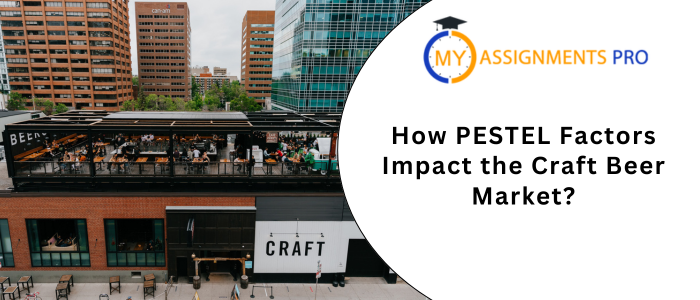
The craft beer movement represents a major cultural and economic upheaval and not a mere hysteria. With microbreweries sprouting everywhere in the world, it has become vital to understand the factors determining their success. This is where a PESTEL analysis of craft beer industry plays a role. This strategic tool analyzed external factors affecting decisions in the craft beer sector. A sound understanding of examples of the PESTEL framework can never go wrong-whether you are a student handing out a marketing or business assignment, or an entrepreneur in the brewing sector venturing into the business.
From this blog, you will learn how each element of PESTEL Political, Economic, Social, Technological, Environmental, and Legal) would be affecting the craft beer industry. You will also learn some market research information, industry trends in the craft beer industry, and how My Assignments Pro can help achieve your educational and professional goals.
What Is a PESTEL Analysis?
PESTEL analysis of craft beer industry is a significant strategic tool used to comprehend external influences on any business environment, particularly in dynamic industries such as craft brewing. Six macroenvironmental factors can influence an industry: political, economic, social, technical, environmental, and legal (PESTEL).
The craft beer industry's PESTEL study aids in determining how outside factors impact marketing, regulations, customer behavior, and brewing operations. Businesses and students engaged in planning, strategic management, or market research will find this approach very helpful. Brewers and marketers can better grasp the potential and hazards in the external environment by dissecting each component.
For example, external factors like rising excise taxes (Political), inflation rates (Economic), changing consumer preferences (Social), brewing technology improvements, environmental concerns (Environmental), and health legislation (Legal) may have an impact on the craft beer market study.
PESTEL framework examples are commonly used by businesses to improve their craft beer marketing strategies and by students in projects to explore market forces.
Whether you're researching for a report or examining the launch of a new beer, the PESTEL study template offers a comprehensive awareness of external market circumstances, making it an important tool for evaluating craft beer company issues in a constantly changing marketplace.
Political Factors Affecting the Craft Beer Industry!
Political forces play a significant role in the external environment analysis craft beer industry. These elements, as important to the PESTEL analysis of craft beer industry, indicate how politics, laws, and policies affect beer production, distribution, and marketing.
Government Regulations and Licensing Laws
Strict licensing and alcohol regulating requirements that differ between nations and even within areas must be taken into account while analyzing the craft beer business. These rules impose restrictions on production, advertising, packaging, and the drinking age. For instance, relative to big commercial breweries, microbreweries often have stricter operating limitations, which may affect their competitive advantage and expansion potential.
Taxation and Excise Duties
Excise taxes and alcohol taxes are two of the largest challenges to the craft beer industry. Craft beer prices can be directly affected by an increase in tax rates, which can decrease consumer affordability and profit margins for small breweries. A PESTEL analysis of craft beer industry needs to be aware of any alterations in the taxation of alcohol.
Trade Policies and Tariffs
Production expenses can be affected by trade policies and tariffs charged on materials imported (e.g., barley and hops). Negative trade policies can lead to supply chain disruptions for craft brewers reliant on foreign sourcing, especially in countries with political instability or trade tensions.
Political Stability and Support
Political stability provides a climate favorable to investment and entrepreneurship. Certain craft beer industry trends, which are positive, have resulted from governments of respective areas promoting local brewing via community campaigns, grants, or subsidies. Alternatively, political instability or policy uncertainty can deter investment in the craft beer industry.
Economic Influences on the Craft Beer Market
Both the supply and demand sides of the craft beer sector are significantly influenced by the state of the economy. Breweries hoping for long-term success must comprehend how economic trends affect consumer behavior, production costs, and market stability as part of a thorough PESTEL analysis of the craft beer industry.
Consumer Purchasing Power and Spending Habits
The change in consumer spending according to economic cycles is one of the major patterns in the craft beer sector. Households tend to try out premium products such as craft beers when the economy is growing. Price-sensitive consumers, on the other hand, may scale back on purchases when there is a recession or an inflationary period, impacting overall sales.
Cost of Raw Materials and Ingredients
Research into the craft brewery business must take into account volatile raw materials costs like barley, hops, yeast, and packaging because raw materials have the potential to be costly. Economic conditions like inflation, supply chain interruptions, or exchange rate changes can cause increasing costs and leave tiny breweries scrambling just to stay profitable. The present unstable world economy poses one of the biggest challenges for the craft brewery business.
Labor Costs and Employment Rates
Another important economic factor is labor. Rising labor expenses, especially in developed markets, can put a burden on brewery budgets, according to the PESTEL analysis of craft beer industry. Conversely, areas with higher employment rates and better earnings tend to see more demand for high-end goods like craft beer, which increases total revenue.
Interest Rates and Investment Opportunities
Interest rates and other economic factors affect investments and development strategies. A brewery's ability to grow or replace its machinery can be limited by high interest rates that could discourage borrowing. Falling rates, however, can bring in new competition and lead to market saturation. When determining competition and viability for investment, this is an important aspect of a craft beer market analysis.
Tourism and Local Economies
Craft beer is often linked with local events and tourism. Under their marketing strategy for craft beer, breweries may leverage the fact that economic prosperity in a region boosts tourism, boosting demand in pubs, taprooms, and local events. Economic recessions can stifle tourism and reduce these revenue sources.
Social Trends Driving Craft Beer Growth!
Societal factors play an essential role in the growth path of the market, brand choice, and consumer habits in the case of PESTEL analysis of craft beer industry. To remain competitive and topical, breweries must remain sensitive to these social factors since the expectations of customers keep evolving.
The Rise of Craft Culture and Community Identity
The local and artisanal product trend is among the largest trends in the craft beer industry. Craft breweries that are about sustainability, small-batch brewing, and community identity resonate with consumers today who value authenticity. Long-term expansion is driven by this highly developed sense of social belonging and local pride, which promotes loyalty.
Millennials and Gen Z Preferences
The younger generations, particularly Gen Z and Millennials, are redefining the beverage industry. These consumers are seeking new tastes, new brewing processes, and responsible sources. The craft beer marketing strategy has come to be focused on transparency, variety, and green initiatives because of this demographic shift, which has also driven demand higher.
Health-Conscious Consumption
A growing factor in craft beer examination of the external environment is health consciousness. Some drinkers are opting for low-ABV or non-alcoholic craft beer varieties, or decreasing alcohol consumption. Breweries need to innovate without sacrificing taste and quality, which presents both opportunity and challenge for the craft beer sector.
Social Media Influence and Brand Engagement
The relationships between consumers and craft breweries have been altered by social media. Social media platforms such as Instagram and TikTok play a crucial role in product launches, promotions, and narratives. Leveraging user-generated ratings, behind-the-scenes brewing narratives, and visually engaging material to connect with consumers is a savvy PESTEL analysis of craft beer industry.
Shift Toward Experiential Drinking
Consumers of today are looking for experiences rather than just goods. Craft beer's lifestyle component includes brewery tours, beer tastings, taproom visits, and collaborative brews. Predicting long-term customer engagement requires that your craft beer market study take this tendency into account.
Technological Advancements in Craft Brewing!
Technology plays a main role in shaping how modern breweries operate, innovate, and compete, based on the PESTEL analysis of craft beer industry. Increased use of new technology continues to influence the entire performance of the craft beer market, from manufacturing to marketing.
Automation and Smart Brewing Systems
One of the most self-evident trends in the craft brewing industry is its mounting automation. Automated brewing technologies assist small-batch brewers who want to scale up by ensuring manual consistency, minimizing manual errors, and enhancing efficiency. These technologies address such primary concerns for the craft beer industry trends as maintaining quality while increasing production.
Use of Data Analytics and Software
Predictive analytics techniques and brewery management software are revolutionizing the industry. Demand forecasting, quality assurance, and inventory tracking are all aided by these digital technologies. Businesses may make more informed decisions about production and distribution by doing a thorough market research of the craft beer industry. This is a crucial illustration of how technology directly influences business success in the PESTEL framework.
E-Commerce and Direct-to-Consumer Sales
Old-fashioned distribution channels are evolving due to the growth in internet beer sales. Mobile ordering platforms, apps, and online websites are becoming more important elements of an up-to-date craft beer marketing strategy. They allow small breweries to access more customers and offer personalized customer service, something that was hard using old retail methods.
Social Media and Digital Marketing Tools
Breweries may now more easily communicate with their consumers, promote new goods, and tell their brand story thanks to digital tools. Targeted advertising, influencer collaborations, and AI-generated content are viewed as clever strategies to increase awareness in a saturated market in the external environment analysis craft beer.
Sustainable Brewing Technologies
Sustainability is increasingly being prioritized by technology. Brewing systems include waste reduction procedures, renewable energy use, and water-saving methods. In addition to satisfying customer demands, these also comply with changing environmental laws—a convergence of the ecological and technological facets of the PESTEL study of the craft beer sector.
Environmental Considerations in Brewing
Environmental concerns have been identified as one of the most urgent challenges and innovation drivers for contemporary brewers among the six pillars of the PESTEL analysis of the craft beer industry. Both manufacturing processes and consumer expectations are changing as a result of the increased need for sustainable practices.
Reducing Water Consumption
Although water is an essential material in brewing beer, excessive usage can have damaging effects on the environment and raise the costs of doing business. To conserve wastage and conform to international sustainability levels, other breweries are embracing water-saving systems more and more. This is a prime illustration of how environmental responsibility and craft beer business challenges interact.
Sustainable Sourcing of Ingredients
Sustainable sourcing, from locally grown grains to organic hops, is a top trend in craft beer. These types of practices are worth any craft beer marketing campaign because they drive down carbon footprints, create jobs for local economies, and bring in earth-conscious consumers.
Waste Management and Recycling Initiatives
Wastewater, packaging materials, and spent grains are among the many waste products produced by breweries. Breweries nowadays are putting recycling plans into place, turning trash into fertilizer or animal feed, and creating innovative packaging out of recyclable or biodegradable materials. Within the examples of the PESTEL framework, these techniques handle a number of issues.
Legal Challenges in the Craft Beer Industry!
Legislation plays an enormous role in how the craft beer industry unfolds. The statutory side of the PESTEL analysis of craft beer industry often presents challenging issues that affect distribution, marketing, manufacturing, and compliance. Existing breweries and entrants wishing to thrive in this competitive industry need to understand these legislative hurdles.
Licensing and Compliance Requirements
To operate lawfully, craft breweries need to get a variety of licenses, such as those for production, distribution, and serving alcohol. These differ by state, nation, and even locality. License applications that are denied or delayed can put a stop to production schedules and have a direct effect on the marketing strategy and launch dates for craft beers.
Labeling and Advertising Laws
Thus, stricter regulations are being passed in terms of labeling, alcohol content, and health warnings. Furthermore, advertising alcohol is prohibited toward a specific population, such as the child population. Now, by dint of these laws, craft brewing stands seriously challenged because of penalties or damage to their branding due to noncompliance.
Trademark and Intellectual Property Issues
Numerous legal problems have resulted from naming conflicts and label similarities as more breweries enter the market. PESTEL analysis of craft beer industry now must include brand identity protection, particularly as businesses grow domestically or internationally.
Health and Safety Regulations
Standards for food safety and personnel health must be followed by breweries. This covers the safe handling of brewing supplies, the use of clean water, and facility sanitation. Breaking these rules puts you at risk of product recalls, public outrage, and legal action.
Import and Export Restrictions
It's critical for brewers looking to expand overseas to comprehend local labeling regulations, trade rules, and tariffs. These guidelines illustrate how global legal environments impact company choices and are a part of the larger PESTEL framework examples.
Having trouble understanding the intricacies of the craft beer industry's PESTEL study for your assignment? You're not by yourself. Linking real-world craft beer business trends and insights with political, economic, social, technological, environmental, and legal factors is difficult for many students. The amount of research and analysis needed might be daunting, regardless of whether you're analyzing the craft beer market, assessing business difficulties, or developing an effective craft beer marketing plan. Our business strategy assignment help can help with this.
Our academic specialists specialize in crafting customized assignments that correspond with the most recent case studies and examples of the PESTEL framework. In order to assist you in presenting arguments supported by reliable facts and industry expertise, we streamline the process of finding and evaluating external environment elements.
We guarantee that your work satisfies academic standards and has a significant impact, whether you need help with writing, editing, or simply polishing your craft beer assignment. Our Business assignment help services are prompt, private, and intended to assist you in achieving academic success.
Mitchell
Mitchell is a seasoned Ph.D. scholar with extensive expertise gained through years of rigorous research, publication, and teaching experience. He brings a wealth of knowledge and analytical skills to tackle complex academic challenges. His work is dedicated to delivering innovative solutions, advancing knowledge, and promoting academic excellence. Proficient in research methodology, data analysis, and scholarly writing, Mitchell has contributed to peer-reviewed journals and mentored students to achieve academic success.


